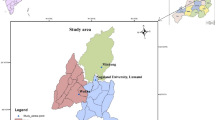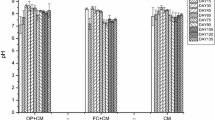Abstract
Purpose
Recovering the nutrients from organic solid residues is an ever demanding approach in terms of eco-friendly management. In this study, the efficiency of the earthworms, Perionyx ceylanensis and Perionyx excavatus in recycling and recovering plant nutrients from urban and agricultural biomass residues was investigated.
Methods
Vermicomposting of four different types of organic biomass resources in combination with cowdung (1:1) for 50 days was conducted using the earthworms, P. ceylanensis, and P. excavatus. Physico-chemical, microbiological and maturity characteristics of the final product were analyzed.
Results
Results showed a decrease in pH, organic matter content (OMC), total organic carbon (TOC), cellulose, lignin, carbon to nitrogen (C/N) and carbon to phosphorus (C/P) ratios, and an increase in total Kjeldahl nitrogen (TKN), phosphorus (TP), potassium (TP), calcium and sodium in vermicomposts over composts (prepared without earthworms). TKN increase in vermicomposts over composts was insignificant between P. ceylanensis and P. excavatus, while it was significant for TP, TK, and total microbial population (P < 0.05). The reduction of TOC, OMC, C/N, and C/P ratios were significantly higher in vermicomposts recovered from P. ceylanensis than P. excavatus. The results clearly indicated that physico-chemical and microbiological changes are dependent on the nature of organic resources and earthworm species used. The seed germination tests with black gram and sorghum showed that the vermicomposts were mature and non-phytotoxic.
Conclusion
P. ceylanensis is equally efficient in recovering nutrients from organic biomass residues to that of a widely used, P. excavatus. Therefore, both P. ceylanensis and P. excavatus are efficiently used for recovering nutrients from urban and agricultural biomass residues and for vermifertilizer production.
Graphic Abstract






Similar content being viewed by others
References
Ghatak, T.K.: Municipal solid waste management in india: a few unaddressed issues. Proc. Environ. Sci. 35, 169–175 (2016). https://doi.org/10.1016/j.proenv.2016.07.071
Gupta, N., Yadav, K.K., Kumar, V.: A review on current status of municipal solid waste management in India. J. Environ. Sci. (China). 37, 206–217 (2015). https://doi.org/10.1016/j.jes.2015.01.034
AESA: Good Practices 22: Utilization of sugarcane trash for livestock feeding: An alternative to on-farm burning. Agricultural Extension in Sourth Asia, Hyderabad, India. pp.1–9. https://www.aesanetwork.org/utilization-of-sugarcane-trash-for-livestock-feeding-a. (2018)
Sood, J.: Not a waste until wasted. Down to Earth, 17 August 2015, (2015)
Gadde, B., Menke, C., Wassmann, R.: Rice straw as a renewable energy source in India, Thailand, and the Philippines: overall potential and limitations for energy contribution and greenhouse gas mitigation. Biomass Bioenerg. 33, 1532–1546 (2009). https://doi.org/10.1016/J.BIOMBIOE.2009.07.018
Jusoh, M.L.C., Manaf, L.A., Latiff, P.A.: Composting of rice straw with effective microorganisms (EM) and its influence on compost quality. Iran. J. Environ. Health Sci. Eng. 10, 17 (2013). https://doi.org/10.1186/1735-2746-10-17
Ramnarain, Y.I., Ansari, A.A., Ori, L.: Vermicomposting of different organic materials using the epigeic earthworm Eisenia foetida. Int. J. Recycl. Org. Waste Agric. 8, 23–36 (2018). https://doi.org/10.1007/s40093-018-0225-7
Kalyani, K.A., Pandey, K.K.: Waste to energy status in India: a short review. Renew. Sustain. Energy Rev. 31, 113–120 (2014). https://doi.org/10.1016/J.RSER.2013.11.020
Bhattacharya, S.S., Kim, K.-H.: Utilization of coal ash: is vermitechnology a sustainable avenue? Renew. Sustain. Energy Rev. 58, 1376–1386 (2016). https://doi.org/10.1016/J.RSER.2015.12.345
Yadav, A., Garg, V.K.: Biotransformation of bakery industry sludge into valuable product using vermicomposting. Bioresour. Technol. 274, 512–517 (2019). https://doi.org/10.1016/j.biortech.2018.12.023
Bhat, S.A., Singh, S., Singh, J., Kumar, S., Bhawana, Vig, A.P.: Bioremediation and detoxification of industrial wastes by earthworms: vermicompost as powerful crop nutrient in sustainable agriculture. Bioresour. Technol. 252, 172–179 (2018)
Ravindran, B., Lee, S.R., Chang, S.W., Nguyen, D.D., Chung, W.J., Balasubramanian, B., Mupambwa, H.A., Arasu, M.V., Al-Dhabi, N.A., Sekaran, G.: Positive effects of compost and vermicompost produced from tannery waste-animal fleshing on the growth and yield of commercial crop-tomato (Lycopersicon esculentum L.) plant. J. Environ. Manag. 234, 154–158 (2019). https://doi.org/10.1016/J.JENVMAN.2018.12.100
Košnář, Z., Wiesnerová, L., Částková, T., Kroulíková, S., Bouček, J., Mercl, F., Tlustoš, P.: Bioremediation of polycyclic aromatic hydrocarbons (PAHs) present in biomass fly ash by co-composting and co-vermicomposting. J. Hazard. Mater. 369, 79–86 (2019). https://doi.org/10.1016/J.JHAZMAT.2019.02.037
Soobhany, N.: Insight into the recovery of nutrients from organic solid waste through biochemical conversion processes for fertilizer production: a review. J. Clean. Prod. 241, 118413 (2019). https://doi.org/10.1016/j.jclepro.2019.118413
Dominguez, J., Edwards, C.A.: Biology and ecology of earthworm species used for vermicomposting. In: Clive Edwards, A., Norman Arancon, Q., Sherman, Rhonda (eds.) Vermiculture Technology: Earthworms, Organic Wastes, and Environmental Management. CRC Press, Boca Raton (2010)
Kale, R.D., Bano, K., Krishnamoorthy, R.W.: Potential of Perionyx excavatus for utilizing organic wastes. Pedobiologia 23, 419–426 (1982)
Reinecke, A.J., Hallatt, L.: Growth and cocoon production of Perionyx excavatus (Oligochaeta). Biol. Fertil. Soils 8, 303–306 (1989). https://doi.org/10.1007/BF00263159
Edwards, C.A., Dominguez, J., Neuhauser, E.F.: Growth and reproduction of Perionyx excavatus (Perr.) (Megascolecidae) as factors in organic waste management. Biol. Fertil. Soils 27, 155–161 (1998). https://doi.org/10.1007/s003740050414
Hallatt, L., Reinecke, A.J., Viljoen, S.A.: Life cycle of the oriental compost worm Perionyx excavatus (Oligochaeta). S. Afr. J. Zool. 25, 41–45 (1990). https://doi.org/10.1080/02541858.1990.11448187
Chaudhuri, P.S., Pal, T.K., Bhattacharjee, G., Dey, S.K.: Rubber leaf litters (Hevea brasiliensis, var RRIM 600) as vermiculture substrate for epigeic earthworms, Perionyx excavatus, Eudrilus eugeniae and Eisenia fetida: the 7th international symposium on earthworm ecology · Cardiff · Wales · 2002. Pedobiologia 47, 796–800 (2003). https://doi.org/10.1078/0031-4056-00261
Suthar, S.: Nutrient changes and biodynamics of epigeic earthworm Perionyx excavatus (Perrier) during recycling of some agriculture wastes. Bioresour. Technol. 98, 1608–1614 (2007). https://doi.org/10.1016/J.BIORTECH.2006.06.001
Suthar, S., Singh, S.: Vermicomposting of domestic waste by using two epigeic earthworms (Perionyx excavatus and Perionyx sansibaricus). Int. J. Environ. Sci. Technol. 5, 99–106 (2008). https://doi.org/10.1007/BF03326002
Khwairakpam, M., Bhargava, R.: Bioconversion of filter mud using vermicomposting employing two exotic and one local earthworm species. Bioresour. Technol. 100, 5846–5852 (2009). https://doi.org/10.1016/j.biortech.2009.06.038
Deka, H., Deka, S., Baruah, C.K., Das, J., Hoque, S., Sarma, H., Sarma, N.S.: Vermicomposting potentiality of Perionyx excavatus for recycling of waste biomass of java citronella—An aromatic oil yielding plant. Bioresour. Technol. 102, 11212–11217 (2011). https://doi.org/10.1016/j.biortech.2011.09.102
Hussain, N., Das, S., Goswami, L., Das, P., Sahariah, B., Bhattacharya, S.S.: Intensification of vermitechnology for kitchen vegetable waste and paddy straw employing earthworm consortium: assessment of maturity time, microbial community structure, and economic benefit. J. Clean. Produc. (2018). https://doi.org/10.1016/j.jclepro.2018.01.241
Yuvaraj, A., Karmegam, N., Thangaraj, R.: Vermistabilization of paper mill sludge by an epigeic earthworm Perionyx excavatus: mitigation strategies for sustainable environmental management. Ecol. Eng. 120, 187–197 (2018). https://doi.org/10.1016/j.ecoleng.2018.06.008
Ananthavalli, R., Ramadas, V., John Paul, J.A., Karunai Selvi, B., Karmegam, N.: Seaweeds as bioresources for vermicompost production using the earthworm, Perionyx excavatus (Perrier). Bioresour. Technol. 275, 394–401 (2019)
Prakash, M., Karmegam, N.: Vermistabilization of pressmud using Perionyx ceylanensis Mich. Bioresour. Technol. 101, 8464–8468 (2010). https://doi.org/10.1016/j.biortech.2010.06.002
John Paul, J.A., Karmegam, N., Daniel, T.: Municipal solid waste (MSW) vermicomposting with an epigeic earthworm Perionyx ceylanensis Mich. Bioresour. Technol. 102, 6769–6773 (2011). https://doi.org/10.1016/j.biortech.2011.03.089
Karmegam, N., Daniel, T.: Growth, reproductive biology and life cycle of the vermicomposting earthworm, Perionyx ceylanensis Mich. (Oligochaeta: Megascolecidae). Bioresour. Technol. 100, 4790–4796 (2009). https://doi.org/10.1016/j.biortech.2009.05.004
Karmegam, N., Daniel, T.: Investigating efficiency of Lampito mauritii (Kinberg) and Perionyx ceylanensis Michaelsen for vermicomposting of different types of organic substrates. Environmentalist. 29, 287–300 (2009). https://doi.org/10.1007/s10669-008-9195-z
Soobhany, N., Mohee, R., Garg, V.K.: Recovery of nutrient from municipal solid waste by composting and vermicomposting using earthworm Eudrilus eugeniae. J. Environ. Chem. Eng. 3, 2931–2942 (2015). https://doi.org/10.1016/J.JECE.2015.10.025
Walkley, A., Black, I.A.: An examination of the degtjareff method for determining soil organic matter, and a proposed modification of the chromic acid titration method. Soil Sci. 37, 29–38 (1934). https://doi.org/10.1097/00010694-193401000-00003
Tandon, H.Z.: Methods of Analysis of Soils, Plant Water and Fertilizers. Fertilizer Development and Consultation Organization, New Delhi (1993)
Chesson, A.: The maceration of linen flax under anaerobic conditions. J. Appl. Bacteriol. 45, 219–230 (1978). https://doi.org/10.1111/j.1365-2672.1978.tb04217.x
Updegraff, D.M.: Utilization of cellulose from waste paper by Myrothecium verrucaria. Biotechnol. Bioeng. 13, 77–97 (1971). https://doi.org/10.1002/bit.260130106
Subba Rao, N.S.: Soil Micro-organisms and Plant Growth. Oxford and IBH Publishing Co. Pvt. Ltd, New Delhi (1995)
Karmegam, N., Vijayan, P., Prakash, M., John Paul, J.A.: Vermicomposting of paper industry sludge with cowdung and green manure plants using Eisenia fetida: a viable option for cleaner and enriched vermicompost production. J. Clean. Prod. 228, 718–728 (2019). https://doi.org/10.1016/j.jclepro.2019.04.313
UAF: University of Alaska Fairbanks: Commercial agriculture development procedures for the wet towel germination test. FGV-00249; 5-91/DQ-TJ/400. (2010)
Benech Arnold, R.L., Fenner, M., Edwards, P.J.: Changes in germinability, ABA content and ABA embryonic sensitivity in developing seeds of Sorghum bicolor (L.) Moench induced by water stress during grain filling. New Phytol. 118, 339–347 (1991)
Ravindran, B., Contreras-Ramos, S.M., Sekaran, G.: Changes in earthworm gut associated enzymes and microbial diversity on the treatment of fermented tannery waste using epigeic earthworm Eudrilus eugeniae. Ecol. Eng. 74, 394–401 (2015). https://doi.org/10.1016/j.ecoleng.2014.10.014
Sharma, K., Garg, V.K.: Comparative analysis of vermicompost quality produced from rice straw and paper waste employing earthworm Eisenia fetida (Sav.). Bioresour. Technol. 250, 708–715 (2018). https://doi.org/10.1016/j.biortech.2017.11.101
Lv, B., Zhang, D., Cui, Y., Yin, F.: Effects of C/N ratio and earthworms on greenhouse gas emissions during vermicomposting of sewage sludge. Bioresour. Technol. 268, 408–414 (2018). https://doi.org/10.1016/j.biortech.2018.08.004
Yuvaraj, A., Karmegam, N., Tripathi, S., Kannan, S., Thangaraj, R.: Environment-friendly management of textile mill wastewater sludge using epigeic earthworms: bioaccumulation of heavy metals and metallothionein production. J. Environ. Manag. In press. (2019). https://doi.org/10.1016/j.jenvman.2019.109813
Negi, R., Suthar, S.: Degradation of paper mill wastewater sludge and cow dung by brown-rot fungi Oligoporus placenta and earthworm (Eisenia fetida) during vermicomposting. J. Clean. Prod. 201, 842–852 (2018). https://doi.org/10.1016/j.jclepro.2018.08.068
Ananthavalli, R., Ramadas, V., John Paul, J.A., Karunai Selvi, B., Karmegam, N.: Vermistabilization of seaweeds using an indigenous earthworm species, Perionyx excavatus (Perrier). Ecol. Eng. 130, 23–31 (2019). https://doi.org/10.1016/j.ecoleng.2019.02.001
Parthasarathi, K., Balamurugan, M., Prashija, K.V., Jayanthi, L., Ameer Basha, S.: Potential of Perionyx excavatus (Perrier) in lignocellulosic solid waste management and quality vermifertilizer production for soil health. Int. J. Recycl. Org. Waste Agric. 5, 65–86 (2016). https://doi.org/10.1007/s40093-016-0118-6
Prashija, K.V., Parthasarathi, K.: Management of agroindustrial lignocellulosic wastes through vermitechnology and production of agronomic valid vermicompost. Int. J. Biotechnol. Wellness Ind. 5, 153–167 (2016). https://doi.org/10.6000/1927-3037.2016.05.04.5
Biruntha, M., Karmegam, N., Archana, J., Karunai Selvi, B., John Paul, J.A., Balamuralikrishnan, B., Chang, S.W., Ravindran, B.: Vermiconversion of biowastes with low-to-high C/N ratio into value added vermicompost. Bioresour. Technol. (2019). https://doi.org/10.1016/j.biortech.2019.122398
Chen, Y., Chang, S.K.C., Chen, J., Zhang, Q., Yu, H.: Characterization of microbial community succession during vermicomposting of medicinal herbal residues. Bioresour. Technol. 249, 542–549 (2018). https://doi.org/10.1016/j.biortech.2017.10.021
Abbasi, S.A., Hussain, N., Tauseef, S.M., Abbasi, T.: A novel FLippable Units vermireactor train system—FLUVTS—for rapidly vermicomposting paper waste to an organic fertilizer. J. Clean. Prod. 198, 917–930 (2018). https://doi.org/10.1016/j.jclepro.2018.07.040
Arancon, N.Q., Pant, A., Radovich, T., Hue, N.V., Potter, J.K., Converse, C.E.: Seed germination and seedling growth of tomato and lettuce as affected by vermicompost water extracts (teas). HortScience 47, 1722–1728 (2012). https://doi.org/10.21273/HORTSCI.47.12.1722
Lazcano, C., Sampedro, L., Zas, R., Domínguez, J.: Vermicompost enhances germination of the maritime pine (Pinus pinaster Ait.). New For. 39, 387–400 (2010). https://doi.org/10.1007/s11056-009-9178-z
Khatua, C., Sengupta, S., Krishna Balla, V., Kundu, B., Chakraborti, A., Tripathi, S.: Dynamics of organic matter decomposition during vermicomposting of banana stem waste using Eisenia fetida. Waste Manage. 79, 287–295 (2018). https://doi.org/10.1016/j.wasman.2018.07.043
Acknowledgements
The first author, Dr. M. Biruntha, thankfully acknowledges RUSA Scheme Phase 2.0 grant [F-24-51/2014–U, Policy (TNMulti-Gen), Dept of Edn., Govt. of India, dated 09.10.2018] for supporting the work. The authors duly acknowledge Dr. (Mrs.) Thilagavathy Daniel, Professor (Retd.), Department of Biology, The Gandhigram Rural Institute (Deemed University), Gandhigram, Tamil Nadu, India for going through the manuscript and critical comments.
Author information
Authors and Affiliations
Corresponding author
Ethics declarations
Conflict of interest
The authors declare that they have no conflict of interest.
Additional information
Publisher's Note
Springer Nature remains neutral with regard to jurisdictional claims in published maps and institutional affiliations.
Rights and permissions
About this article
Cite this article
Biruntha, M., Mariappan, P., Karunai Selvi, B. et al. Vermiremediation of Urban and Agricultural Biomass Residues for Nutrient Recovery and Vermifertilizer Production. Waste Biomass Valor 11, 6483–6497 (2020). https://doi.org/10.1007/s12649-019-00899-0
Received:
Accepted:
Published:
Issue Date:
DOI: https://doi.org/10.1007/s12649-019-00899-0




